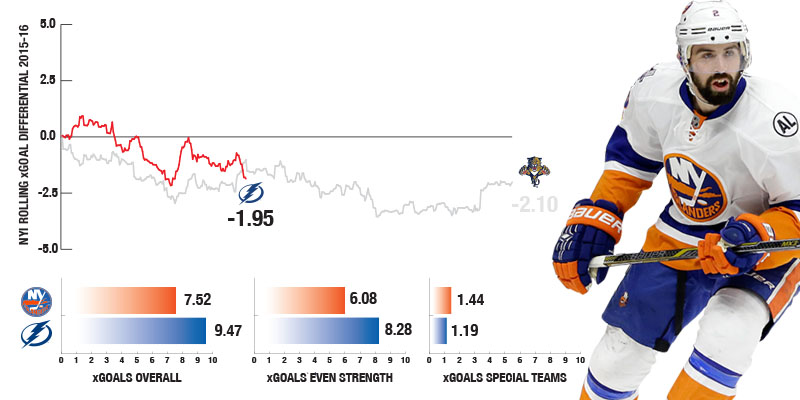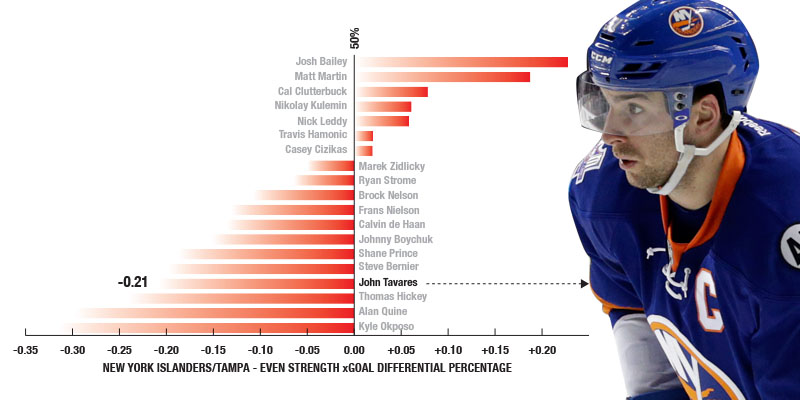If the Islanders could have survived the last 40 seconds of Game 3, they would be leading their best-of-seven series two games to one and be in a strong position to take control of the series Friday night. Instead, the Islanders are trailing by one game.
The Islanders gave their best effort of the series at home in Game 3, but like the Rangers before them, they continue to ride unsustainable high percentage performances for their playoff success.
In the first round against the Panthers, the Isles got an incredible performance from John Tavares and an unexpected advantage in goal when Thomas Greiss outperformed Roberto Luongo. The Islanders struggled to push play. History has proven this to be unsustainable in the playoffs. It results in small sample upsets, but as the playoffs move on, teams are required to drive the play. This is shown in possession metrics and one of the reasons I like to use weighted possession in the form of expected goal totals.
I use shot location and pre-shot movement (passes, rebounds, tips) to determine the quality of an opportunity and then create a goal probability. These factors are extremely important to force a goaltender into situations where they cannot gather information or gain clear sight of the puck.
Through nine games, the Islanders are losing this battle.

In the chart above, we can see the Islanders expected goal differential in both series. The grey bar indicates the Panthers series. The Panthers were consistently outchancing the Islanders for the majority of the series. The red line indicates the Lightning series and the Islanders are going down the same dangerous path. The Lightning are outplaying the Islanders at even strength and the slight power play differential in New York’s favor is not enough to shift the needle significantly.
This worked against Florida because the Islanders got an unsustainable performance from Greiss, who was tracking in the Carey Price, Henrik Lundqvist category. His numbers have dropped vs. Tampa, not specifically because of him, but because the Islanders have not provided him with the same environment they did against the Panthers.
Through three games in this series, Greiss’ clear sight percentage has dropped from 88% in the first round to 79%. This means that almost a quarter of the shots that he is facing against the Lightning are high-quality opportunities with nine slot line passes, eight deflections and four rebounds. Six less than he faced through all six games in Round 1.
The Islanders also had Tavares walking all over the Panthers with a .580 expected goal differential. Fifty-eight percent of the high-quality opportunities on the ice were directed at the Panthers goal while he was on the ice in the first round. That total has fallen to 21% versus the Lightning’s top line of Nikita Kucherov, Tyler Johnson and Ondrej Palat. While Tavares and Okposo are on the ice, the Lightning are getting 8 of every 10 scoring opportunities. Tavares has struggled to break free of the defensive coverage of Victor Hedman, Braydon Coburn and Jason Garrison, who occupy the ice for the majority of the time he is out there.

The Islanders are producing 88% of the shots with clear sight for Ben Bishop to deal with, and aside from his Game 1 performance, he has been outplaying Roberto Luongo through the following three games.
Using data provided by Sportslogiq, I found that the offensive zone isn’t where I found the greatest struggle, it lied in their defensive zone where the offense is initiated. The Islanders are struggling with loose puck recoveries in their own zone. They are down 20 loose puck recoveries per game from the first round. This is a problem for defending, but it also hampers their ability to initiate their offense. When they do establish control after a recovery, they are having difficulty with controlled exits. These are also down 22 defensive zone exits per game (11 carries, 11 passes). Without sustained breakouts, it is difficult for the defense to initiate the transition.

We can see above how effective carrying the puck out of your own zone can be and the problems it can cause when you carry speed through the neutral zone. Nick Leddy exits his zone, the transition starts something he has been successful at 42 times in the three games so far. Tampa sets up into its trap a little too late and the poor neutral zone spacing allows Leddy a controlled zone exit and a controlled zone entry. That speed forces gap control issues for the Lightning and opens passing lanes for Leddy to exploit, which he does for a high percentage slot line feed and slot line cross for Frans Nielson, which results in a shot that is successful every one in five opportunities.
These exits and entries are the backbones of a strong offense and when the opposition defensive structure removes this from your game, then you must dump the puck in and dominate loose puck recoveries. Unfortunately, this is also an area of the Islanders’ game that Tampa has controlled. New York is down 14 offensive loose puck recoveries per game. The Islanders are beginning to adjust though, as they have steadily increased from 57 to 75 to 92 per game. This led to their best offensive performance of the series in Game 3 as they only allowed Bishop clear sight on 75% of his shots. This resulted in a well-earned, four-goal outburst and what should have been a well-earned victory.

The addition of Josh Bailey in Game 3 was a huge boost to the Islanders and his first goal was set up beautifully on a loose puck recovery by Nikolay Kulemin. Once Kulemin regains control, we can see the spacing in the slot area which can be exploited. The Tampa defender ducks behind the net and Bailey recognizes that Kulemin has won the battle and exploits the spacing in the slot. This resulted in a high-quality slot line feed, which is converted one in every three tries.
While the Islanders are a little unlucky to be down 2-1, they are beginning to show signs of their offense waking up. If they can maintain their loose puck recovery improvement, improve their exits and entries and gain offensive flexibility from Bailey’s return to free up Tavares from Hedman and the Lightning’s top line, they will extend this series and greatly increase their odds of winning it.